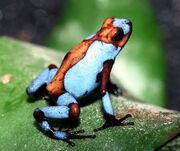| Harlequin poison dart frog | |
|---|---|
 | |
| Physical description | |
| Binomial name | Oophaga histrionica |
| Habitat | Tropical rainforest |
| Lifespan | 8-15+ years |
| Average Size | 2.5-3.75 cm (1.0-1.5 in) |
| Average weight | 5-6 grams |
| Diet | Insectivorous |
| Conservational Status | |
| Status | Near threatened |
| IUCN status | 3.1 |
| Scientific classification | |
| Phylum | Chordata |
| Class | Amphibia |
| Order | Anura |
| Family | Dendrobatidae |
| Genus | Oophaga |
| Species | O. histrionica |
| Distribution | |
| Distribution of species | El Choco, Colombia |
The harlequin poison dart frog, Oophaga histrionica, is a species of poison dart frog. It is endemic to the El Choco region of Colombia and is one of the most variable poison dart frogs known. It is also the largest of the Oophaga species, growing up to 3.75 cm long and approaching Dendrobates auratus in size.
Poison[]
Unlike many of the dendrobatine poison dart frogs, the harlequin poison dart frog contains histrionicotoxin, a deadly cardiotoxin only found in the harlequin poison dart frog and the closely allied O. speciosa. Histrionicotoxin is morere four or five species from the Phyllobates genus.
Description[]
Oophaga histrionica is the largest of its genus. Males grow to 3.50 cm (1.4 inches) long; the slightly larger females reach 3.75 cm (1.5 inches) long. The species is extremely variable, however, and some individuals may be as small as 2.5 cm, barely larger than other Oophaga species.

This is the largest morph of O. histrionica, rivalling Dendrobates auratus.
In addition to being variable in size, the harlequin poison dart frog is also variably coloured and patterened. The frog may be primarily brown, primarily green (or yellow), or primarily powder blue. If primarily brown, the contrasting color is frequently an irregular pattern of green or yellow spots. If primarily green or yellow, the contrasting color is usually a reticulum of black or dark brown. If primarily powder blue, the contrasting color is usually wood or dead-leaf brown. The feet and toes of all morphs are black, usually splotched with the predominant color. Like all arboreal Oophaga species, the toes of histrionica possess discs to aid it in climbing of plants. The toe discs are not as large as those on O. lehmanni or pumilio, but are more adhesive. This is due to the fact that O. histrionica is more persistently arboreal than many other species of poison dart frogs.

